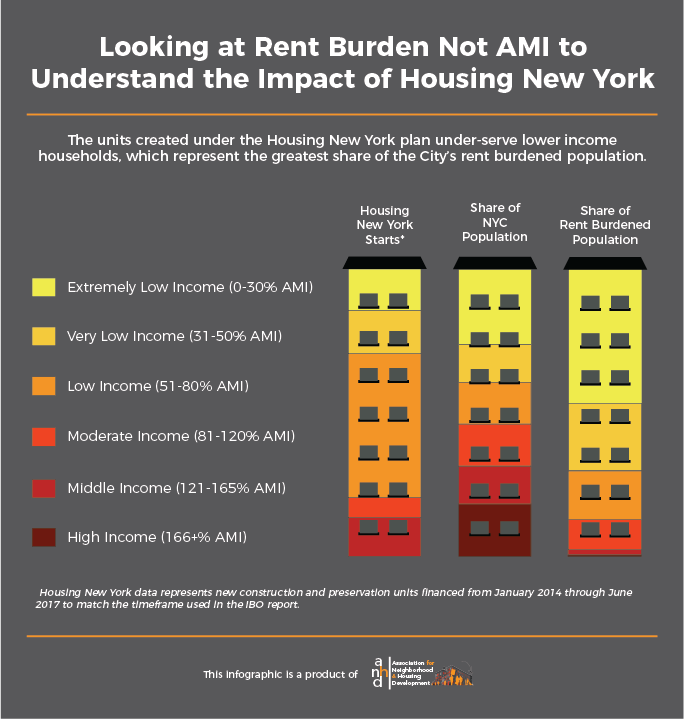
The ANHD Blog raises the profile of our issues, and educates our member groups, city decision makers, and the general public on our core issue areas. The ANHD Blog offers sharp, timely and effective commentary on key public policy issues, as well as our work and the work of our member groups.
All of our blogs are sorted based on the issues, projects, special tags, and dates they are associated with, and you can use the dropdowns below to filter through our blogs based on these tags. Additionally, you can do a general search through our blog, using the search bar the right. If you can’t find what you are looking for, email comms@anhd.org.
Getting at the Need: The Case for Looking at Rent Burden Not AMI to Understand the Impact of Housing New York
What Median Household Income Doesn't Show
The New York City Independent Budget Office (IBO) recently released a new report that examines the affordability levels of housing created under Mayor de Blasio’s Housing New York plan relative to local neighborhood incomes. The findings were mixed – the report showed that the majority of subsidized units built were affordable to income levels below the neighborhood median, which suggests that the City’s plans are creating a foothold for low-income New Yorkers in neighborhoods that would otherwise be unaffordable to them. But at the same time, the report showed that 25% of units are priced higher than what the average neighborhood household can afford – with the greatest number of moderate-income units being placed in low-income communities where they are out of reach for current residents.
ANHD recognizes some of the notable strides the de Blasio Administration has taken to create more deeply affordable housing, but, we echo the concerns raised by the IBO and City Limits. As City Limits noted, many affordable housing advocates question whether any units ought to be priced higher than what average neighborhood households can afford, given the severity of the affordability crisis in these communities. ANHD would take the question a step further: is the relationship between median household income of a neighborhood and the income targets of housing built by the City the best way to measure the success of the City’s housing strategies? We suggest that it isn’t. Median household income looks at the overall population of a neighborhood, or of the city as a whole, but that does not reflect the population most in need of affordable housing. If we focus instead on households that are rent burdened and take this as a more meaningful indicator of affordable housing need, we see that the units created under the Housing New York Plan are under-serving lower income households.

Even if the City were creating housing reflective of the city’s, or a neighborhood’s, current income breakdown, those at the bottom would still be disproportionately rent-burdened. In fairness, over the past six years, the de Blasio administration has taken important steps to create financing tools and policies that can achieve deeper levels of affordability, including in 2015 when they issued a new affordable housing term sheet that reached “Very Low” and “Extremely Low” levels of affordability. Prior to 2015, there was no standard income category for city-backed development below “Low Income,” making this a crucial financing tool in the development of deeply affordable housing. Although the total number and the percentage of “Extremely Low” Income and “Very Low” Income units built under the de Blasio plan to date are modest, they represent a meaningful advance in New York City housing development policy. Still, the City must do more to address the needs of the most vulnerable and make its goal not equality – creating an equal share of units across the income spectrum – but instead on equity – focusing efforts where they’re needed most.
Subsidized units under the Housing New York plan are also only one area of city policy shifting the overall balance of housing available at different income levels. Land use policy has a huge impact on how much affordable and market rate housing is likely to be built in different neighborhoods. The rezonings the de Blasio administration has pushed forward over the past several years will further skew overall housing affordability levels in many neighborhoods away from lower income households where the need is greatest. Community Districts 4 & 5 in the Bronx, site of the Jerome Avenue rezoning approved last year, serve as a good illustration. Here, incomes are lower and rent burden is higher than citywide. In recent years, the City has been doing a relatively good job of trying to respond to that need, with close to half of units financed through June 2017 serving households below 50% AMI, as opposed to less than a third of units citywide. When looking at just new construction, these numbers were even stronger, with over a third of new affordable units being built for households below 30% AMI, the most rent burdened households in the district.

But the Jerome Avenue rezoning threatens to change this dynamic. Even under the City’s best case scenario, the projected units this rezoning is expected to produce will mostly be out of reach for the community. At the same time, this influx of market-rate units is likely to change the local real estate market in a way that makes partnerships with the City less attractive to developers, making it harder for the City to continue to finance the deeply affordable units it’s been subsidizing under Housing New York.

There is unlikely to ever be one simple policy solution to New York City’s affordability crisis. But looking holistically at how all of the City’s policies impact affordability, and targeting resources to where need is greatest, are good places to start.





